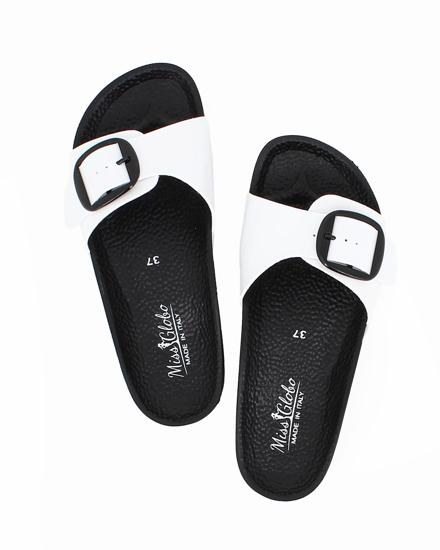
Globo E-Commerce - Calzature, Abbigliamento, Sport, Intimo, Accessori - MISS GLOBO- Ciabatta da bagno bianca lucido con doppia fibbia

Globo E-Commerce - Calzature, Abbigliamento, Sport, Intimo, Accessori - MISS GLOBO- Ciabatta da bagno bianca lucido con fibbia

Globo E-Commerce - Calzature, Abbigliamento, Sport, Intimo, Accessori - MISS GLOBO - Ciabatta camel con catena

Globo E-Commerce - Calzature, Abbigliamento, Sport, Intimo, Accessori - MISS GLOBO - Ciabatta verde con punta quadrata, catena sulla fascia e sottopiede in VERA PELLE, MADE IN ITALY

Globo E-Commerce - Calzature, Abbigliamento, Sport, Intimo, Accessori - MISS GLOBO - Ciabatta bianca con punta quadrata, catena sulla fascia e sottopiede in VERA PELLE, MADE IN ITALY

Globo E-Commerce - Calzature, Abbigliamento, Sport, Intimo, Accessori - MISS GLOBO - Sandalo rosa pastello tacco 9,5cm

Globo E-Commerce - Calzature, Abbigliamento, Sport, Intimo, Accessori - MISS GLOBO - Ciabatta rosa con strass sulla fascia

Globo E-Commerce - Calzature, Abbigliamento, Sport, Intimo, Accessori - MISS GLOBO- Ciabatta con fascia strass

Globo E-Commerce - Calzature, Abbigliamento, Sport, Intimo, Accessori - MISS GLOBO- Ciabatta cammello decorata con pietre e conchiglie

Globo E-Commerce - Calzature, Abbigliamento, Sport, Intimo, Accessori - MISS GLOBO - Ciabatta verde con catena

Globo E-Commerce - Calzature, Abbigliamento, Sport, Intimo, Accessori - MISS GLOBO - Ciabatta con punta quadrata e fascia intrecciata, tacco 9CM

Globo E-Commerce - Calzature, Abbigliamento, Sport, Intimo, Accessori - MISS GLOBO- Ciabatta infradito nera decorata con perline

Globo E-Commerce - Calzature, Abbigliamento, Sport, Intimo, Accessori - MISS GLOBO - Sandalo infradito con doppia pietra gioiello

Globo E-Commerce - Calzature, Abbigliamento, Sport, Intimo, Accessori - MISS GLOBO - CIABATTA ZATTERONE ORO TACCO 14CM

Globo E-Commerce - Calzature, Abbigliamento, Sport, Intimo, Accessori - MISS GLOBO - Ciabatta fucsia con punta quadrata, catena sulla fascia e sottopiede in VERA PELLE, MADE IN ITALY

Globo E-Commerce - Calzature, Abbigliamento, Sport, Intimo, Accessori - MISS GLOBO- Ciabatta infradito con pietre e bordo strass

Globo E-Commerce - Calzature, Abbigliamento, Sport, Intimo, Accessori - MISS GLOBO- Ciabatta da bagno fuxia lucido con fibbia

Globo E-Commerce - Calzature, Abbigliamento, Sport, Intimo, Accessori - MISS GLOBO - CIABATTA BEIGE CON CATENA ORO SULLA FASCIA

Globo E-Commerce - Calzature, Abbigliamento, Sport, Intimo, Accessori - MISS GLOBO - CIABATTA ROSA CON PUNTA QUADRATA E STRASS SULLA FASCIA, TACCO 2CM

Globo E-Commerce - Calzature, Abbigliamento, Sport, Intimo, Accessori - MISS GLOBO - Ciabatta con punta quadrata e fascia intrecciata

Globo E-Commerce - Calzature, Abbigliamento, Sport, Intimo, Accessori - MISS GLOBO - Ciabatta nera con punta quadrata, catena sulla fascia e sottopiede in VERA PELLE, MADE IN ITALY

Globo E-Commerce - Calzature, Abbigliamento, Sport, Intimo, Accessori - MISS GLOBO- Ciabatta nera con fibbia oro

Globo E-Commerce - Calzature, Abbigliamento, Sport, Intimo, Accessori - MISS GLOBO - Sandalo glitterato blu con punta quadrata, sottopiede in VERA PELLE e cinturino alla caviglia, tacco 7,5CM

Globo E-Commerce - Calzature, Abbigliamento, Sport, Intimo, Accessori - MISS GLOBO - CIABATTA NERA CON PUNTA QUADRATA E STRASS SULLA FASCIA, TACCO 2CM
